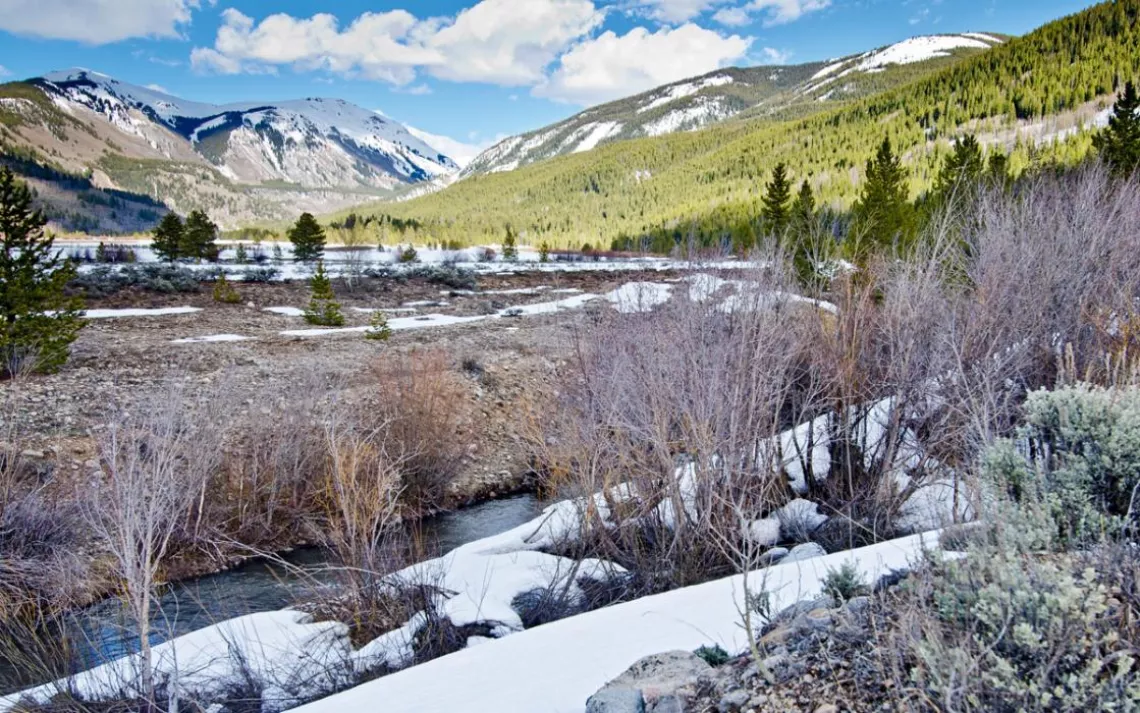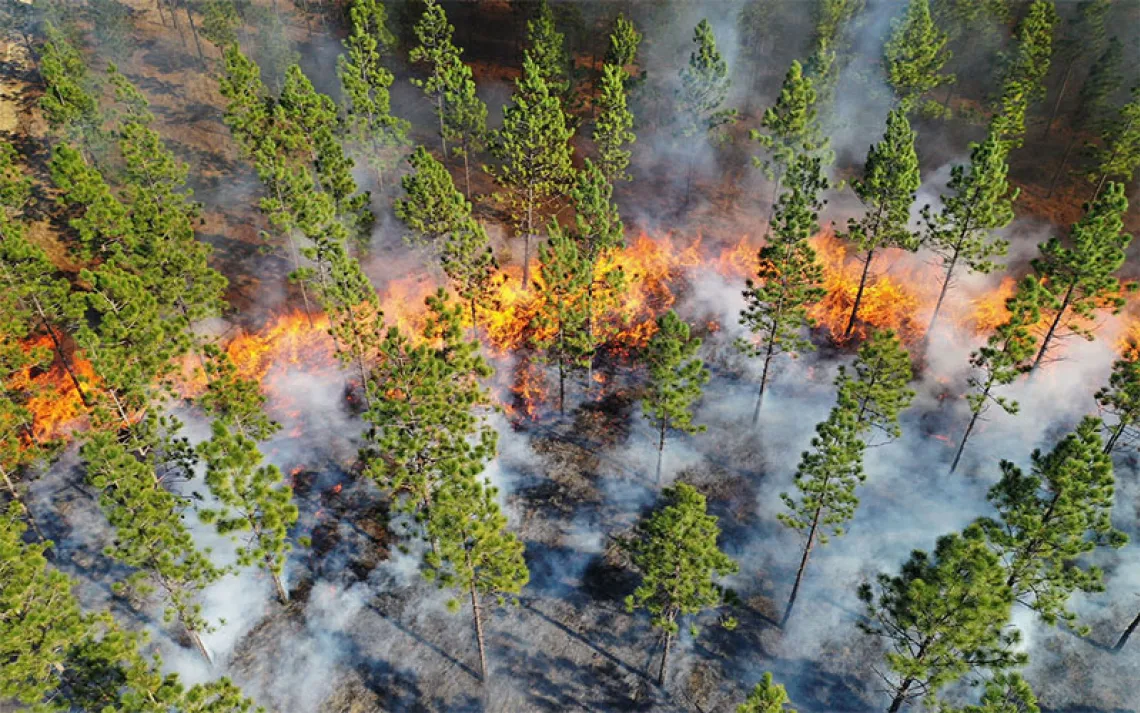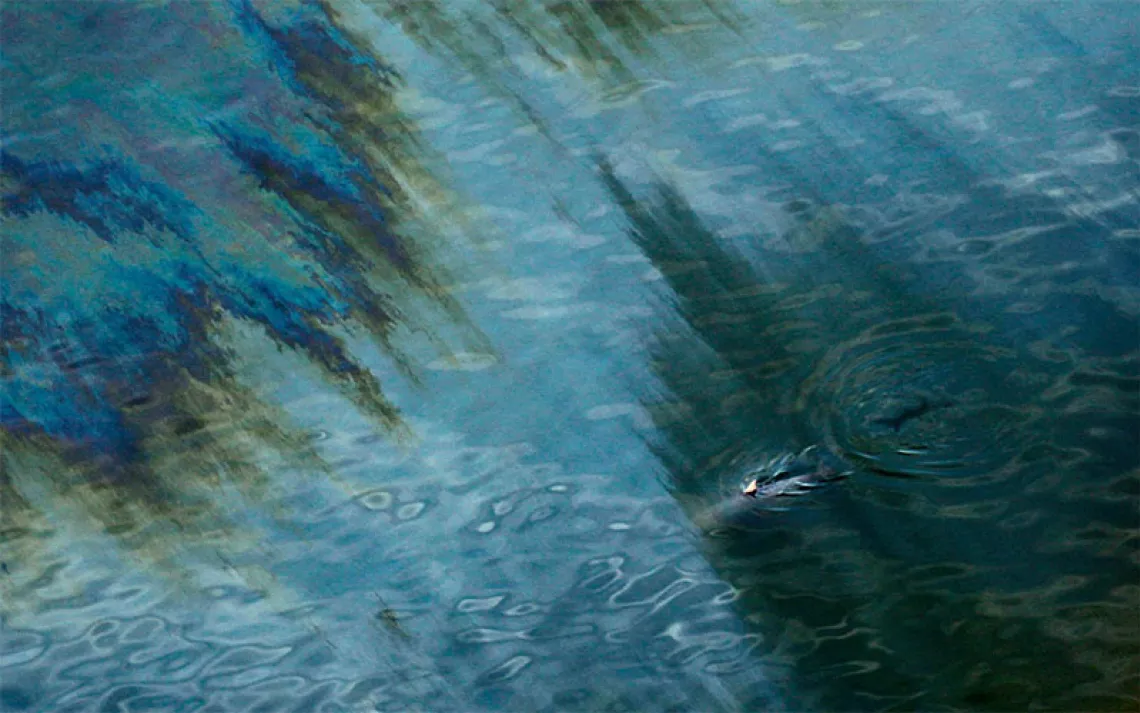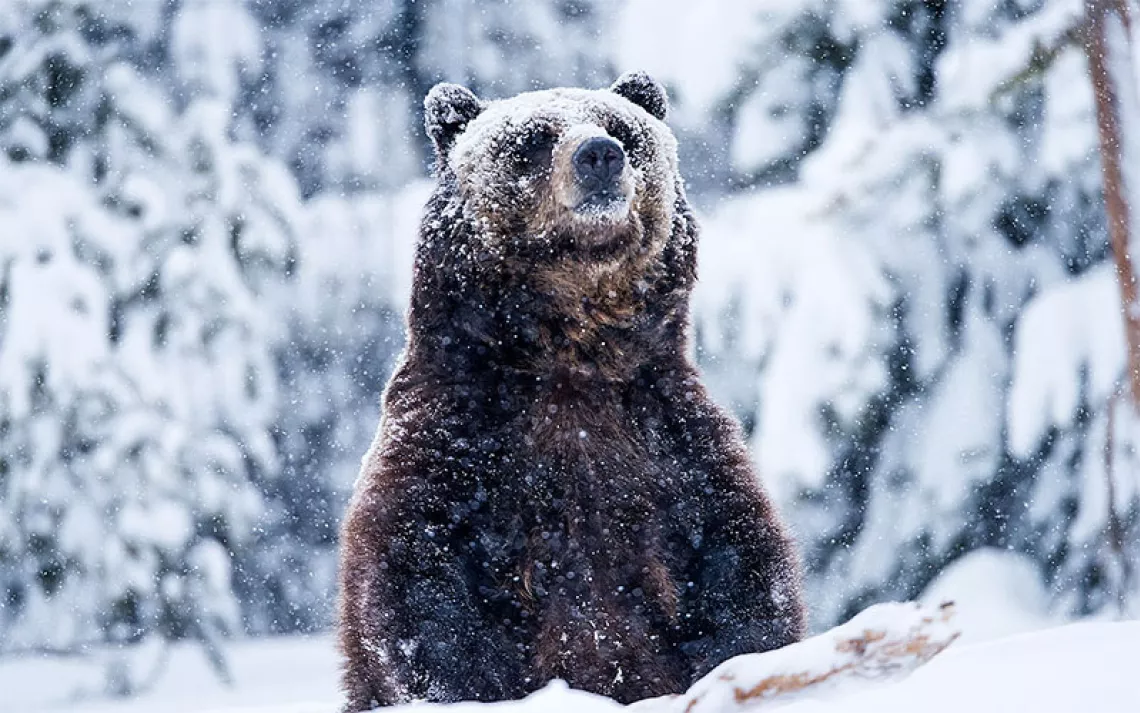Colorado's Camp Hale Could Pioneer a New Mode of Land Protection
Could a wilderness designation suit both conservationists' and recreationists' agendas?

Colorado's Eagle River flows from Tennessee Pass through historic Camp Hale. | Photo by Steven DeWitt
WHEN WORLD WAR II VETERAN Dick Over thinks about Camp Hale, dampness and cold come to mind. And a whole lot of smoke. It came from the railroad that ran through this high-altitude military training base in Colorado's central Rockies, home to the U.S. Army's 10th Mountain Division—an elite group of soldiers on skis that included the Sierra Club's own David Brower. As coal-burning trains arrived daily to disgorge troops and supplies, "they would pour black smoke through the camp," Over says. "A lot of people developed lung congestion."
From November 1942 through June 1944, Camp Hale housed some 15,000 troops, who learned to rock climb, perform military maneuvers on skis, and endure a brutal climate in preparation for mountain warfare in the Second World War. The constant buzz of activity took its toll on the land. When Over arrived in 1942 as a recently enlisted 18-year-old, "the place was a mess," he remembers. "It was mud from top to bottom."
Visit Camp Hale today, and the image of a bustling army base requires a huge leap of imagination. The Eagle River, which flows from Tennessee Pass to the east, neatly bisects an immense meadow at 9,200 feet. In summer, clusters of wildflowers, sagebrush, and willows dot the land where row upon row of white barracks and other buildings—some 800 in all—once stood. In winter, a level blanket of snow drapes everything. Only the outlines of a busy grid of roads, a handful of street signs, and some concrete remains signal the infrastructure that once supported the troops here. The only sounds are the rushing flow of the river, which was redirected in 1942 to afford soldiers railroad access, and intermittent vehicle noise from two-lane Highway 24.
Though Camp Hale's WWII-era physical attributes are largely gone, the 10th Mountain Division lives on. After a couple of hiatuses, the 10th was reactivated in 1985 at Fort Drum, New York, and since then its troops have been deployed to Iraq, Somalia, Bosnia, and Afghanistan. Thanks to a recently introduced pilot-training program that connects Army Reserve and National Guard units with active-duty military, the division also has a presence in Colorado for the first time since the days of Camp Hale. No matter where they're based, members of the 10th uniformly honor their alpine legacy by retaining the Mountain tab on their sleeve insignia.
Veterans of the original infantries, many of whom were experienced skiers recruited to the army from college race teams, alpine clubs, and resort ski patrols, wielded great influence on the ski industry, propelling the 10th Mountain Division from history into legacy. Now, that legacy may be further enhanced, as Democratic Senator Michael Bennet plans to propose making Camp Hale (already on the National Register of Historic Places) the country's first national historic landscape. The proposed bill would complement another bill, the Continental Divide Wilderness and Recreation Act, introduced by Democratic Colorado representative Jared Polis in May 2015.
If the bills pass, the land will be protected from logging and mining. And Camp Hale, in the White River National Forest, will forge a new form of public lands protection—just as it once helped build the American ski industry as we know it.
IN 1940, FOUR SKIING PIONEERS (including Charles "Minnie" Dole, who had started the National Ski Patrol two years earlier) came up with a novel idea: an elite army division specializing in mountain warfare. Inspired by the initial successes of Finnish troops on skis during the Soviet invasion the year before, they envisioned a similarly trained division of U.S. troops that could advance and retreat stealthily and quickly on snow.
The army researched potential training venues across the country and ultimately, in 1942, constructed Camp Hale on former ranchland in Colorado's Pando Valley, between Minturn and Leadville, in just eight months. It remains the only site the U.S. Army has ever developed specifically for mountain and winter training.
"The actual landscape is unique," says Garett Reppenhagen, Rocky Mountain region director for the Vet Voice Foundation, a nonprofit that encourages veterans to become involved in civic issues, including conservation. "It was chosen for the topography, the severe weather, and the opportunities to train in that climate."
If military training on skis sounds at all appealing, try doing it on seven-foot-long boards in deep snow and subzero temperatures with a 90-pound rucksack and a rifle on your back. "Wet weather and cold were the biggest things we had to overcome," Over says. "It got down to 30 below zero many nights."
Despite the rugged challenges—which often resulted in frostbite, hypothermia, and acute exhaustion—many soldiers fell in love with the mountains. Those who earned weekends off would pay $1.50 each for a bus ride to Aspen, then a burgeoning ski area, where they experienced mountain-town camaraderie. "We'd sleep and eat at the famous old Hotel Jerome—one dollar for a room, a dollar-fifty for a Sunday prime rib dinner with violin and piano accompaniment," wrote Vail founder and 10th Mountain vet Pete Seibert in his memoir, Vail: Triumph of a Dream. Summers weren't so bad, either, Over says: "A lot of fellows had fishing gear as a standard part of their packs."
IN LATE 1944, THE 10TH MOUNTAIN TROOPS entered combat in Europe. During their first major battle, the soldiers covertly scaled a snow-covered, 1,500-vertical-foot cliff late one February night to reach Riva Ridge in Italy's Apennine Alps, site of a heavily fortified German observation post. After five days of fighting, the Allied forces commandeered a series of defended posts, which allowed the division to stage an assault on Mt. Belvedere, succeeding where others had failed, and to advance into the Po Valley. These key victories helped break the German stranglehold on northern Italy. During its five months of combat in 1945, the 10th lost almost 1,000 men, and another 4,000 were wounded. It became one of the most decorated units of the war.

Map by Steve Stankiewicz
After the war ended in May 1945, the 10th Mountain Division troops returned to the United States, where many made for the snowy peaks they had grown to love while stationed in Colorado. "They were really the genesis of the ski industry," says Tom Hames, board chair of the 10th Mountain Foundation, a nonprofit that built a memorial atop Tennessee Pass honoring the division's 992 fallen troops. Some 2,000 vets went on to work as ski instructors and patrollers; others took administrative jobs at the new resorts. Former 10th Mountain members themselves founded a dozen resorts, including Colorado's Arapahoe Basin and Vail; Washington's Crystal Mountain; Vermont's Sugarbush; and Oregon's Mount Bachelor. They either developed or ran ski schools at 62 U.S. ski areas.
Adds John Dakin, vice president of communications for the Colorado Ski and Snowboard Museum in Vail, "They were able to come back and jump right into a postwar America that found itself with more leisure time and disposable income to pursue activities like skiing, which changed from being a sport of the wealthy to a sport of the masses." Further driving the ski industry's growth? All the surplus ski equipment the army sold off for cheap after the war.
Some vets became leaders in the fledgling outdoors industry, like Bill Bowerman, who came home to coach track and cofounded Nike (with Phil Knight) in 1964, and Paul Petzoldt, who in 1965 started the National Outdoor Leadership School. And, of course, David Brower, a 10th Mountain officer, trainer, and bronze-star recipient, went on to become the Sierra Club's first executive director.
Architect Fritz Benedict, who spent three years in the 10th, settled in Aspen after the war and helped create master plans for ski resorts such as Breckenridge, Snowmass, and Vail; his best-known contribution, however, is the 10th Mountain Division Hut Association in Colorado's central mountains, which he helped found in 1982. Now counting 13 huts and thousands of annual visitors, the system serves as many skiers' introduction to the backcountry. Several huts honor 10th Mountain soldiers, with stories, letters, and photos from members of the 10th on display. Trail access for two of them begins at Camp Hale.
IF CAMP HALE IS INCLUDED in Bennet's proposed legislation, the site's fate will hinge on a new approach toward public lands protection. To strike a balance between the often-conflicting agendas of conservation and recreation, the proposed Senate version would include the novel "national historic landscape" designation. "It's perhaps a template for how to do wilderness in the 21st century," says Susie Kincade, a grassroots activist with the Continental Divide Coalition, a conservation group working within the White River National Forest.
Together, the two pieces of legislation, says Representative Polis, could provide "perpetual protection" for more than 80,000 acres in the White River National Forest, if Camp Hale is included. (White River is the country's most visited national forest, though about two-thirds of those visits occur within ski areas like Vail and Aspen, on leased U.S. Forest Service land.) That protection would be divvied up in several ways. Almost 39,500 acres in Eagle and Summit Counties would constitute traditional wilderness, with no motorized travel allowed. Another 11,400 acres would be designated as the Tenmile Recreation Management Area, which would benefit from wilderness-style safeguards but still allow mountain bike access. The Porcupine Gulch Protection Area, made up of about 5,200 acres, would conserve wildlife habitat near the busy Eisenhower Tunnel along Interstate 70.
Camp Hale encompasses up to 30,000 acres. With mountain bike trails, snowmobile trails, and existing permits in place for the longtime local guide service, it was never a candidate for traditional wilderness designation. All of that recreational use would likely continue, but the land would be protected from resource extraction and further development. The historic landscape status could also help with ongoing cleanup of leftover asbestos and equipment from the army days, as well as a plan to restore the Eagle River to its natural, meandering course while reclaiming wetlands that disappeared when the waterway was straightened.
"It's not just a wilderness bill. It's more of a comprehensive public lands and recreation type of legislation," says Scott Braden, a wilderness advocate with Conservation Colorado. "I'd like to say it was all strategy from the get-go, but it was definitely an evolution—we started from an inclusive and broad stakeholder coalition to see how we could protect the land while sustaining and nurturing outdoor recreation and historical interpretation."
Vet Voice supports the historic landscape status for Camp Hale, says Reppenhagen, as long as the diverse recreational activities can continue. He also welcomes the opportunity to teach visitors more about the area's significant past. "We want to make sure that's an important piece, so when people come to recreate, they can learn about the 10th Mountain Division," he says.
Also backing the historic designation of this unusually formative landscape? Veterans like Dick Over. "We covered so much territory in that valley and the mountains surrounding it," he recalls. "It was a big part of our lives that expanded into the postwar, and to this day."
Whenever he visits Camp Hale to camp or hike, Over says, "it's like coming home."
This article appeared in the November/December 2017 edition with the headline "A Winning Battle."
 The Magazine of The Sierra Club
The Magazine of The Sierra Club



